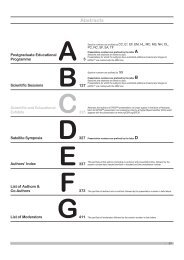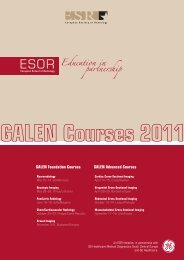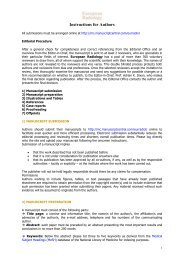Postgraduate Educational Programme - myESR.org
Postgraduate Educational Programme - myESR.org
Postgraduate Educational Programme - myESR.org
- No tags were found...
Create successful ePaper yourself
Turn your PDF publications into a flip-book with our unique Google optimized e-Paper software.
<strong>Postgraduate</strong> <strong>Educational</strong> <strong>Programme</strong>Panel discussion:What training and special skills are radiologists expected to havein order to work with intensive care units? How should we managethe clinical and technical challenges posed by this very specificenvironment? 17:1716:00 - 17:30 Room ZVascularRC 715Dialysis fistulaModerator:H.A. Deutschmann; Graz/ATA-198 16:00A. Preoperative mappingL. Turmel‐Rodrigues; Tours/FR (luc.turmel@wanadoo.fr)Nephrologists and surgeons are increasingly aware of the limitations of physicalexamination as a tool to assess arterial and venous anatomy prior to creating avascular access. Greater emphasis is now being placed upon more objectivemethods. Arterial mapping is feasible almost exclusively by color duplex ultrasonography.Imaging of the veins is indicated if there are inadequate findings on physicalexamination or whenever central vein stenosis is suspected. Iodinated contrastvenography and later carbon dioxide venography were the modalities of choicebefore the advent of ultrasonographic mapping in the 1990s. CT angiography andmagnetic resonance angiography play an equally shrinking role. Anatomic variabilityis a common feature of upper limb vasculature. The most common arterial variantis a high origin of the radial or ulnar artery at any level from the axillary artery tothe elbow. Despite having more anatomical variation than arteries, the cephalicand basilic veins are the predominantly seen veins in the forearm and upper armof normal subjects. At the elbow, the accessory cephalic, main cephalic, mediancubital, and forearm basilic veins converge to form a venous network in the shape ofcapital “M”. Vessel size is usually underestimated since it is not always easy to tellfrom an image if a vein or artery is partially or completely spastic despite warmingor use of vasodilators. There is a wide variation in practice as to what a surgeondoes with a venous mapping report and the vascular access that is finally created.Learning Objectives:1. To become familiar with the indications and techniques for pre-operative arterialvenous mapping.2. To learn about the venous anatomy.3. To become familiar with the potential pitfalls of preoperative mapping.A-200 17:00C. Evaluation of malfunctionR. Uberoi; Oxford/UK (raman.uberoi@orh.nhs.uk)The incidence of end-stage renal disease is increasing, with limited availability oftransplants, hemodialysis accesses have become the most commonly performedtype of vascular surgical procedure.However, only 50% of all haemodialysis accessesremain patent at 3 years and interventional radiology plays a major role inmaintaining function. Indications for intervention include failing haemodialysis graftor fistula, arm oedema, imaging findings indicative of a significant stentosis > 50% orpresence of accessory veins. Clinical assessment alone will detect a large numberof failing fistula's. If the venous pressures during haemodialysis exceed 120 mmHg,fistula flow falls to < 500 ml/min, graft flow decreases to < 650 ml/min, or accessblood flow falls by more than 25%. There remains debate if prophylactive treatementof failing fisutlas results in better outocmes. Venous stenoses are characterisedby extensive fibrosis and require ultra-high pressure balloon inflations or cuttingballoon angioplasty for optimal treatment. Stenting provides no clear benefit overPTA alone and eliminates the option of using the stented vein for future surgicalrevision. Stenting is genenerally reserved for sub-otpimal results with no convincingevidence currently to support using covered stentgrafts over bare nitinol stents.When critical flow reduction and clotting ensue, the bulk of the thrombus is redthrombus, which is rich in fibrin and red cells and easily extracted with aspiration,rheolytic methods or pulse-spray thrombolysis, but a platelet-rich white clot at thearterial anastomosis may require mechanical removal with an angioplasty balloonor devices such as the Fogarty thrombectomy in 35% to 60%.Learning Objectives:1. To understand the main indications and results of angioplasty.2. To learn about thrombectomy and aspiration.3. To become familiar with the indications for stenting.A-199 16:30B. Screening for problemsD. Vorwerk; Ingolstadt/DE (dierk.vorwerk@klinikum‐ingolstadt.de)Dysfunction of dialysis fistulas and grafts is frequent and usually a stenotic processrepresents the underlying cause. While in grafts - in the absence of side branches -this will result in complete thrombosis after reaching a critical stenosis in conjunctionwith thrombophilic circumstances, in fistulas partial thrombosis is not rare leavingsome parts of the fistula patent. There is few scientific work about the value ofregular screening programs in dialysis fistulas and grafts and most did not find inan improved patency after starting surveillance programs by ultrasound. However,reintervention is not a good marker for the success of a surveillance program as itcould be for the purpose of treatment of a stenotic leasion as well as for thrombosis.Definitively reintervention for a restenosis is usually simple, quick, effective andinexpensive while treating a thrombosed fistula or graft is time-consuming, expensiveand technically more challenging. Alternatively to ultrasound, measurementof recirculation is a less time-consuming method to detect dysfunction in additionto clinical exam and palpation.Learning Objectives:1. To understand the spectrum of problems with dialysis fistula.2. To learn about screening protocols and the results of screening.3. To learn about the most common problems and how to detect them.Author Disclosure:D. Vorwerk: Consultant; Covidien, Cook, Bard,. Speaker; Cordis, Gore.S50AB C D E F G













